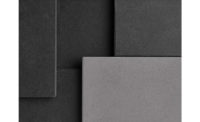It is an interesting time to track self-cleaning, pollution-fighting building products, because the innovative technology behind this category keeps evolving and is now being incorporated into everything from paint to roofing granules to porcelain wall panels.
Typically a self-cleaning coating is one that is made with titanium dioxide—an ingredient they all share—and reacts to sunlight, triggering a breakdown of airborne dirt into water-soluble particles that rain can wash away. There is a caveat, however: A 2013 Indiana University study published in the Journal of the American Chemical Society questions what happens if too many buildings shed too much nitrogen oxide, the byproduct of this self-cleaning process, which can lead to ozone pollution. While the verdict is still out, proponents, though, continue to hold up cost-savings on maintenance compared with more frequent power-washing or manual cleaning of large buildings using detergents in some urban settings.
View the slideshow for a quick sampling of recent developments.
This story was featured in Material World, Architectural Record’s products-focused newsletter. Subscribe today!











